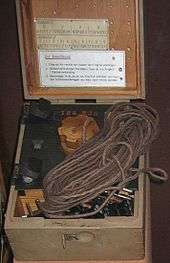Otto Buggisch
Otto Buggisch (June 28, 1910 – September 15, 1991)[1] was a German mathematician[2] who, during World War II, was a cryptanalyst working in the cipher bureau of the Supreme Command of the Armed Forces, the Cipher Department of the High Command of the Wehrmacht (OKW/Chi) responsible for deciphering of the opposing forces Communications. He also dealt with the security control of own key procedures. Thus, he recognized the cryptographic weaknesses of the Enigma rotor key machine used by the German armed forces to encrypt their secret communications.
History

Buggisch graduated from the Ludwig-Georgs Gymnasium (LGG) in Darmstadt in 1928. He studied at the TH (today TU) Darmstadt with the main subjects pure mathematics and physics and the subsidiary subject applied mathematics. In 1932 the scientific examination for the higher Lehramt took place, in 1934 the state examination as a Studienassessor .
According to his mathematical dissertation entitled On the Rarity of Equations with Affect[3] (German: Über die Seltenheit der Gleichungen mit Affekt) which he supervised by Udo Wegner at the Technische Universität Darmstadt in 1938. During the war Dr Buggisch held the military rank of a sergeant [4] in group 7/VI at OKW/Chi. Immediately after the war, he was interviewed extensively by the interrogators of the Target Intelligence Committee (TICOM) on his work. A large part of the available information about him and his activity comes from the interrogation, which were classified as TOP SECRET, which can now be viewed publicly. So his work was very versatile. He has been dealing with recent successes with methods such as TypeX, C-36, M-209 [4] and the Strip Cipher System M-138, as well as with Soviet methods used by British and US Americans The voice encryption method "X2".[5] In addition, he investigated the security of his own procedures, such as T52, T43, SZ40 and the Enigma I used by the German army.
He was well acquainted with the basic methods of attack, such as the use of cribs, which were also highly successful in the deciphering of Enigma by the Allied party under the cover name "Ultra", and recognized some weaknesses of German cryptographic procedures. In addition, Dr Buggisch knew the cryptographic strengths of the Enigma which had been newly developed and partially introduced towards the end of the war, such as the Enigma-Uhr and the Lückenfüllerwalze (Fritz Menzer), i.e. gap fill roller, as the Allies learned after the war through the interrogations.
After World War II
Before the war, he taught at the Old Realgymnasium Darmstadt (1938) and at the Stefan George Gymnasium in Bingen (1938–39). In May, 1939, he was first called to the pioneers. Although not a member of the Nazi party, in 1943, he was appointed as a secondary school teacher (German:Studienrat) [possibly to teach the children of Nazi officials] that was held during his military service. In April 1946 he was released from prison. From 1948 to 1966, he taught at the Ludwig-Georgs-Gymnasium, the preparatory course for foreign students in Darmstadt (1966-1969), and finally as a postgraduate student at the Mathematics Institute of the TH-Darmstadt (1969-1972).
TICOM publications
TICOM was the United States effort to seize German Intelligence after World War 2. Dr Otto Buggisch is mentioned in the following TICOM documents:
- "TICOM I-58 Interrogation of Dr Otto Buggisch of OKW/Chi 8th August 1945" (PDF). TICOM. Retrieved 11 February 2017.
- "TICOM I-46 Preliminary Investigation of Wachtmeister Dr Otto Buggisch (of OKH/Gen. d. NA) and Dr Werner Liebknecht (employed by OKH and OKW as tester of cryptographic equipment) 23rd June 1945" (PDF). TICOM. Retrieved 11 February 2017.
- "TICOM I-64 Answers by Wm. Buggisch sent by TICOM 8th August 1945" (PDF). TICOM. Retrieved 11 February 2017.
- "TICOM I-66 Paper by Dr Otto Buggisch of OKH/In. 7/VI and OKW/Chi on Typex 12 August 1945" (PDF). TICOM. Retrieved 11 February 2017.
- "TICOM I-67 Paper by Dr Otto Buggisch of OKH/In. 7/VI and OKW/Chi on Cryptanalytic Machines 13 August 1945" (PDF). TICOM. Retrieved 13 February 2017.
- "TICOM I-92 Final Interrogation of Wachtmeister Dr Otto Buggisch (OKH/In. 7/VI and OKW/Chi) 25 August 1945" (PDF). TICOM. Retrieved 13 February 2017.
References
- ↑ Wolfgang U. Eckart; Volker Sellin; Eike Wolgast (23 September 2006). Die Universität Heidelberg im Nationalsozialismus. Springer-Verlag. p. 1065. ISBN 978-3-540-39385-6.
- ↑ "Mathematics Genealogy Project Otto Buggisch". genealogy.ams.org. North Dakota State University. Retrieved 3 March 2017.
- ↑ "Über die Seltenheit der Gleichungen mit Affekt - Deutsche Mathematik, Vol. 2, 1937, pp. 685-690". Mathematics Genealogy Project. Mathematics Genealogy Project, Department of Mathematics ,North Dakota State University. 30 April 2005. Retrieved 6 February 2017.
- 1 2 "Army Security Agency: Notes on German High Level Cryptography and Cryptanalysis. European Axis Signal Intelligence in World War II, Vol 2, Washington (D.C.) DOCID:356 0816" (PDF). NSA. TICOM. 1 May 1946. Retrieved 6 February 2017.
- ↑ "TICOM I-58 Interrogation of Dr Otto Buggisch of OKW/Chi 8th August 1945" (PDF). TICOM. Retrieved 11 February 2017.